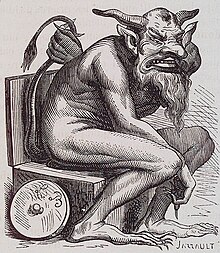Belphegor
This article needs additional citations for verification. (January 2011) |

In demonology, Belphegor (or Beelphegor, Template:Lang-he baʿal-pəʿōr - Lord of the Gap) is a demon, and one of the seven princes of Hell, who "helps" people make discoveries. He seduces people by suggesting to them ingenious inventions that will make them rich. According to some 16th-century demonologists,[who?] his power is stronger in April. Bishop and witch-hunter Peter Binsfeld believed that Belphegor tempts by means of laziness.[1] Also, according to Peter Binsfeld's Binsfeld's Classification of Demons, Belphegor is the chief demon of the deadly sin known as Sloth in Christian tradition.[2]
Belphegor originated as the Assyrian Baal-Peor, the Moabitish god to whom the Israelites became attached in Shittim (Numbers 25:3), which was associated with licentiousness and orgies. It was worshipped in the form of a phallus. As a demon, he is described in Kabbalistic writings as the "disputer", an enemy of the sixth Sephiroth "beauty". When summoned, he can grant riches, the power of discovery and ingenious invention. His role as a demon was to sow discord among men and seduce them to evil through the apportionment of wealth.[citation needed]
The palindromic prime number 1000000000000066600000000000001 is known as Belphegor's Prime, due to the significance of containing the number 666, on both sides enclosed by thirteen zeroes and a one.
According to De Plancy's Dictionnaire Infernal, Belphegor was Hell's ambassador to France. Consequently, his adversary is St Mary Magdalene, one of the patron saints of France. Belphegor also figures in John Milton's Paradise Lost and in Victor Hugo's The Toilers of the Sea.[citation needed]
Popular culture
This section may contain information not important or relevant to the article's subject. (February 2010) |
- Belfegore is an early-1980s Gothic band from Germany.
- Belphegor is a blackened death metal band from Salzburg, Austria.
- Belfagor arcidiavolo aka Il demonio che prese moglie ("The devil who got married") is a short story written in the 16th century by Niccolò Machiavelli.
- Baalphegor is a female archdevil, consort of Mephistopheles—ruler of the Eighth Layer of Hell—in Dungeons & Dragons.
- Belphégor is a 1927 crime novel by Arthur Bernède, which was made into a serial directed by Henri Desfontaines. Belphegor, Phantom of the Louvre is a remake from 2001.
- Ottorino Respighi's opera of 1923 is called Belfagor, and is partially based upon Machiavelli's short story.
- The 7th track of John Zorn's Astaroth: Book of Angels Volume 1 is named after Belphegor in the Hebrew form, Baal-Peor.
References
- ^ Wendy Doniger (1999). Merriam-Webster's Encyclopedia of World Religions. ISBN 0-87779-044-2.
- ^ Encyclopedia of Demons and Demonology, By Rosemary Guiley, p. 28-29, Facts on File, 2009.
